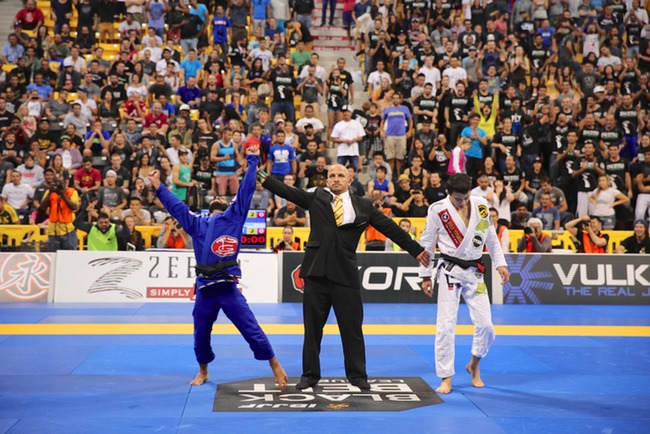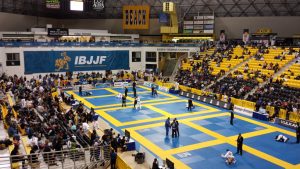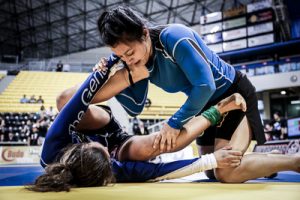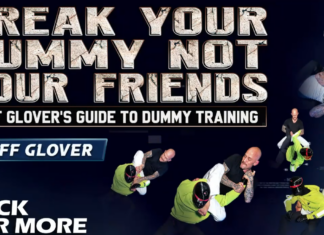
So you decided that you’re ready to step on the mats and give it your all in a Brazilian Jiu Jitsu competition. Well, feeling ready is certainly a step in the right direction, but you might need a bit more to go from. There are two main components to the competition game plan of all the best competitors out there: the mental and the physical aspect. Interestingly, both of these aspects gave their roots in the technical aspect of your Jiu Jitsu.
Setting Up A Competition Game Plan
First and foremost, you must remember that competing in Jiu Jitsu is about fun and improvement, so make sure you stay safe before anything else. Most of us involved in BJJ will probably never get to earn substantial money from competing. With that in mind, the game plan should begin with staying safe while preparing and during the tournament itself. Before we get into the meat and potatoes of building a game plan, remember that your instructor is your best friend. Regardless of your belt level and experience, make sure your instructor is your closest collaborator.
Rule Set Knowledge
Before considering stepping on the mats to proudly represent your academy, get yourself acquainted with the rules format of the tournament you’ve chosen. The best way is to consult your instructor and go over the rules with him/her. Many tournaments have certain limitations in regard to techniques that can be used while competing. Belt level and age are important factors that often determine the finer aspects of competition rule sets.
It’s not smart to go to a tournament, having done everything correctly and get disqualified because you pulled off an illegal move. Study the rules carefully so that you can develop your A game accordingly.
Precise Offensive Style
Hopefully you’re entering the tournament in order to win it. If not, maybe you’re just aiming to win one match. Unless you’re entering to lose (hardly viable, but who knows), you need to be ready to attack. Just going out and throwing techniques out randomly might actually work and get you a win or two, but it is not a legitimate way to go about. It might work at white belt level, or even win you a tournament at blue but that’s about it.
The first part of a competitive game plan is to fine tune your offensive options. Have your instructor help you develop an offensive game based around your strongest attributes. Let’s say that you’re really good at armbarring people. The armbar is your go to submission and you can hit it from both top and bottom positions. However, your takedowns still need work in order to be highly effective in a competition. IF you’re looking to utilize your best weapon you must make sure you have the best way of getting there. So, in our armbar example, you might decide to work on a takedown or two (depending on time) or make sure you’re the best guard puller at the tournament.
If you’re more of a control freak than a submission artist than your offensive training should revolve around positional dominance. Let’s say you have a judo background and your Harai Goshi is out of this world. Stay aware of where your favorite takedown is going to take you and how to get to where you want from there. Harai Goshi leads directly to either side control or knee belly. So, if staying on the back like a koala on a eucalyptus tree is your forte, make sure you know how to transition effectively.
Rock Solid Defense
It’s great to have immense self confidence and believe that you’re the best and you’re going to beat everyone. That’s certainly the attitude you want, but you need to stay grounded as well. Jiu Jitsu is a ruthless teacher of humility, and it will destroy your cockiness in less time than it takes to tap to a tight choke. So be aware that there’s always someone who can beat you at any tournament.
Maybe someone is technically superior, you’ve made a mistake or just got caught. Freak situations aside, put in the time to develop a defensive base for the most common attacks. If you’re a seasoned competitor and know the game of your opponents this is an easy task. If you have no idea who you might face, then you need to cover all your bases.
A good defensive plan should be built around the ability to recognize bad positions before you’re caught in them. An ounce of prevention is worth a pound of cure, right? Positions are harder to prevent than submissions, so accept that you’ll be in a bad spot at some point during competition. As long as you know how to prevent attacking options from, let’s say mount you can stay relatively safe. From tapping out at least.
Escaping the position is a complete different ball game. A good training approach is to do lots of positional sparring from bad positions in order to get comfortable. The more time you spend looking for ways out during rolling, the easier it will be when you’re under the lights. Even if you’re the best submission artist in your category, a single slip can take you to a bad position. Know how to get out, so that you can apply your game and get the “W’.
Identify Weaknesses
Be honest to yourself, and accept the weaknesses that your instructor might point out to you. As mentioned, you’ll most likely get punished for being too sure of yourself. Everyone has a weakness, no matter how well rounded we might think we are.
Identify your greatest weakness and make it the staple of your defensive training. If you have trouble getting out of side control, then make sure you drill it until you enjoy being there. If you have trouble passing the closed guard, on the other hand, you need a different approach. You’ll need to fine tune your offensive options and make sure you have at least one viable way of opening the guard.
Have your weaknesses determine your offensive and defensive competition game plan as much as your strengths do. Maybe even more, in fact.
Carefully Choose Your Corner
One more aspect of the competition game plan development is having a strong corner. Now, having your black belt instructor that works with you regularly is the ideal situation. However, this is not always possible and a team mate might have to step in and corner you. If that’s the case, try and find one that’s more experienced and familiar with your game. It’s important that your corner is able to identify precisely when and where you should use your game plan during the heat of battle.
The Mental Game
Without dwelling too much on the mental aspect (a complete article on the subject in-coming) we’ll cover the basics only. If you’ve decided to enter a competition, you must know why. A clear goal is essential for any athlete involved in competitive endeavours. Once again, your goals should be brave, but attainable and rooted in reality. Your technical knowledge should complement your goals. Your game plan should take you directly towards them without any space for deviations.
Manage expectations diligently and make sure your goals are realistic. They will grow and expand along with your technical knowledge and game plan arsenal.
The Physical Game
You can only win as many matches as you can get through. As simple as this sounds, gassing out is the most common reason for losses in BJJ. It’s not just about how many rolls you can do in training. Add in weight cutting, nerves and adrenaline and suddenly your gas tank capacity is at half. Throw in a tough opponent who has the same level of technical knowledge as you and conditioning becomes the deciding factor.
If doing technical training, rolling and drilling is your main work, then straighten and conditioning is your homework. Apart from shark tank drills (position sparring with a fresh partner every round) it should be done off the mats. Proper prioritization is essential for a successful plan, tailored to a competitors needs.
Building a successful competition game plan is a complex puzzle that needs to be carefully put together. It requires balance as much as bravado and the experience of an instructor that can help you identify your best and worst traits. It’s only when you can put all of the above in a working system, that you can tart racking up the medals.
Transgender’s Letter to BJJ Community – I’m not a Male, I Want to Compete Without Stigma
European Black Belt Promoting A More Realistic Style Of Tournament Fighting


![Darce Choke Encyclopedia – Origins, Mechanics and Variations [2025] BJJ, choke, Brabo, BJJ Darce Choke, D'arce Choke, Darce BJJ Choke](https://bjj-world.com/wp-content/uploads/2017/11/JungPoirierLeeYahoo-218x150.jpg)












![Slicin’ Calves Mikey Musumeci DVD Review [2025] Slicin' Calves Mikey Musumeci DVD Review](https://bjj-world.com/wp-content/uploads/2025/04/slicin-calves-mikey-musumeci-dvd-review-218x150.png)
![Jiu-Jitsu For Old Guys Guard Retention Bernardo Faria DVD Review [2025] Jiu-Jitsu For Old Guys Guard Retention Bernardo Faria DVD Review](https://bjj-world.com/wp-content/uploads/2025/03/old-guys-guard-retention-bernardo-faria-dvd-review-218x150.png)
![X-Guard Trickery Kyle Sleeman DVD Review [2025] X-Guard Trickery Kyle Sleeman DVD Review](https://bjj-world.com/wp-content/uploads/2025/03/x-guard-trickery-kyle-sleeman-dvd-review-218x150.png)
![Countering with Crab Ride Anthony Budion DVD Review [2025] Countering with Crab Ride Anthony Budion DVD Review](https://bjj-world.com/wp-content/uploads/2025/03/countering-with-crab-ride-anthony-budion-dvd-review-218x150.png)
![Closet Closed Guard Craig Jones DVD Review [2025] Closet Closed Guard Craig Jones DVD Review](https://bjj-world.com/wp-content/uploads/2025/03/closet-closed-guard-craig-jones-dvd-review-218x150.png)

![Heavy Top Game Fabiano Scherner BJJ DVD Review [2025] Heavy Top Game Fabiano Scherner BJJ DVD Review](https://bjj-world.com/wp-content/uploads/2025/01/heavy-top-game-fabiano-scherner-bjj-dvd-review-100x70.png)

![Eoghan O’Flanagan Bundle Down Right Sloppy Jiu-Jitsu Review [2024] Eoghan O'Flanagan Bundle Down Right Sloppy Jiu-Jitsu Review 2024](https://bjj-world.com/wp-content/uploads/2024/09/down-right-sloppy-jiu-jitsu-eoghan-oflanagan-bundle-100x70.png)

![The Rack Kyle Watson BJJ DVD Review [2025] The Rack Kyle Watson BJJ DVD Review](https://bjj-world.com/wp-content/uploads/2024/12/the-rack-kyle-watson-bjj-dvd-review-100x70.png)



![Highlight Hip Throws Christian Ozbek DVD Review [2025] Highlight Hip Throws Christian Ozbek DVD Review](https://bjj-world.com/wp-content/uploads/2025/01/highlight-hip-throws-christian-ozbek-dvd-review-100x70.png)
![Grappling Takedown Dominance Brandon Ruiz DVD Review [2025] Grappling Takedown Dominance Brandon Ruiz DVD Review](https://bjj-world.com/wp-content/uploads/2025/01/grappling-takedown-dominance-brandon-ruiz-dvd-review-100x70.png)
![Jiu-Jitsu For Old Guys Guard Retention Bernardo Faria DVD Review [2025] Jiu-Jitsu For Old Guys Guard Retention Bernardo Faria DVD Review](https://bjj-world.com/wp-content/uploads/2025/03/old-guys-guard-retention-bernardo-faria-dvd-review-100x70.png)
![Flow Pressure Kauan Barboza DVD Review [2025] Flow Pressure Kauan Barboza DVD Review](https://bjj-world.com/wp-content/uploads/2025/02/flow-pressure-kauan-barboza-dvd-review-100x70.png)
![Crush The Guard Vagner Rocha DVD Review [2024] Crush The Guard Vagner Rocha DVD Review](https://bjj-world.com/wp-content/uploads/2024/10/crush-the-guard-vagner-rocha-dvd-review-100x70.png)



![Bricks Kesa Gatame System Jeremy Brick DVD Review [2025] Bricks Kesa Gatame System Jeremy Brick DVD Review](https://bjj-world.com/wp-content/uploads/2025/02/bricks-kesa-gatame-system-jeremy-brick-dvd-review-100x70.png)


![Foot Sweep the World Dainis Nguyen-Huu DVD Review [2024] Foot Sweep the World Dainis Nguyen-Huu DVD Review](https://bjj-world.com/wp-content/uploads/2024/11/foot-sweep-the-world-dainis-nguyen-huu-dvd-review-100x70.png)
![Creating Back Exposure Luke Griffith DVD Review [2025] Creating Back Exposure Luke Griffith DVD Review](https://bjj-world.com/wp-content/uploads/2025/01/creating-back-exposure-luke-griffith-dvd-review-100x70.png)

![Reverse Armlock Magid Hage DVD Review [2024] Reverse Armlock Magid Hage DVD Review](https://bjj-world.com/wp-content/uploads/2024/12/reverse-armlock-magid-hage-dvd-review-100x70.png)


![How to Double Leg Anyone Kevin Lee DVD Review [2024] How to Double Leg Anyone Kevin Lee DVD Review](https://bjj-world.com/wp-content/uploads/2024/11/how-to-double-leg-anyone-kevin-lee-dvd-review-100x70.png)
![The Whole Omoplata Enchilada Lyanne Perez DVD Review [2024] The Whole Omoplata Enchilada Lyanne Perez DVD Review](https://bjj-world.com/wp-content/uploads/2024/11/whole-omoplata-enchilada-lyanne-perez-dvd-review-100x70.png)
